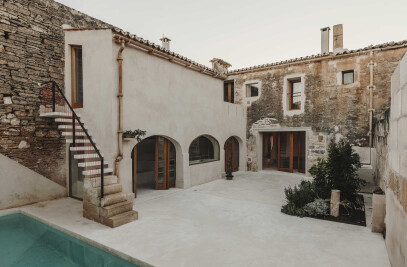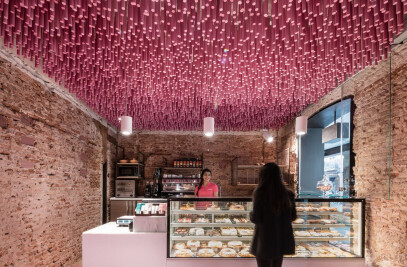L’Atelier opened its doors this past April with the objective of surprising the city of Barcelona, and it has certainly delivered. The IDEO Architectura studio was commissioned to create this concept and make it into a reality. L’Atelier – now a true jewellery case – is a space where pastry, school and bakery coexist at 140 bis Calle Viladomat.

“We are looking for a groundbreaking, unique and avant-garde space”. Using his premise from Pastor, IDEO Architectura had to transform a raw area of 500 m2 in the Eixample of Barcelona into a new space destined to become a leading reference point in the bakery sector. For Virgina del Barco, the space’s architect and designer, the mission was “to generate an architectural universe that responds with clarity to the objectives set by L’Atelier, the name with which both pastry chefs present themselves to the world.”

An atelier is a laboratory made for experimentation with raw materials related to art. These workspaces are places which normally present a disordered, chaotic and magical image. Based on this concept, the team began to work on the project. “We know that both a painting, couture garment or, in our case, a pastry creation, even though they are conceived in spaces where the aesthetics of the place is secondary, are products that will be exhibited for sale in a gallery, a museum or a boutique.
Aesthetics do matter to all of them because their architecture must elevate the high quality product to its highest levels of beauty and exquisiteness,” adds Virginia.

THE IDEA
The name L’Atelier is a declaration of intentions in itself. Eric and Ximena want to show the world their creative universe, without hiding anything. Virginia wondered: Why not merge the apparent chaos of the workshop with the perfect harmony of the pastry boutique into a single space?

This was carried out by the team of architects, capable of giving life to a risky but captivating idea: they left the premises as they were, with their imperfections and installations in sight, and covered it with only a delicate inner skin: a layer of glass just like a jewellery case. In this way, two supposedly contrary worlds were united by a dual architectural complexion; an existing, rugged and imperfect layer, and another new, beautiful and delicate layer.

The thermoclay block that forms the vertical walls, the slabs and columns of exposed concrete, wiring, pipes and downspouts are all visible. They have deliberately not been hidden. However, this bareness, somewhat hostile, faces a pure and sophisticated interior envelope. The construction of a transparent glass box, as if it were a jewellery case, separated twenty centimetres from the walls of the store, has the effect of turning any pastry creation into a small jewel framed in its showcase.

THE MATERIAL
“Building a glass box, both on the walls, floors and ceilings, was exceedingly complicated,” recalls Virginia. However, IDEO Arquitectura managed to make it work. Instead of glass, a semi-transparent polycarbonate panel thirty-three centimetres wide, that was easy to handle and shape, was used instead. This material was also employed to fashion the partitions for the pastry school. Once completed, the outcome reveals the original state of the room in a disguised and diffused manner.

THE COLOUR
IDEO Arquitectura wanted to put the final touches on the cake-jewel concept, and the selection of colour was absolutely crucial. They opted for a range of golds, finally choosing the colour PANTONE 118, ochre with golden tints, responding better to the sobriety of Eric Ortuño’s style. At the first painting phase, all of the bakery walls were painted in this colour. Then after placing the second interior polycarbonate skin, it was immediately also soaked in the same colour, reverberating the ochre-gold throughout the whole space. For the pastry school area, since the second polycarbonate skin was not placed in this part, a simpler solution was chosen. The vertical walls remained gray and only a strip on the ceiling was stained with ochre.

“We did not have much height in the room and we had to expand the spatial sensation in some way, so we replaced the typical continuous plaster with a metal openwork grid. We bathed it in the same ochre colour, with the intention that the school would be captured by the spirit of the bakery.”

THE LIGHTING
The way to illuminate the space was just as important as the selection of the material. For the school, a simple but original solution was to hide the tubes of LED lights on the false gold ceiling. For the bakery, constructed as a box made with polycarbonate, achieving functionality for maintenance and access was a complex challenge. Not wanting to resort to the classic solution of continuous perimeter lighting on the floor, finally a checkerboard of equidistant spotlights was chosen and hidden behind the transparent panel.

THE BUYING AND TASTING EXPERIENCE
Finally, and to respond to sales needs, IDEO Architectura proposed a unique island furniture solution, six metres in length. The key strength lies in that it has no supports, resulting in a powerful overhang that arises from a central pillar in which showcases, cabinets and appliances are hidden behind a continuous finish of gray micro cement.

For the bathroom area a Hisbalit tiled finish in gold and ochre tones was used to raise the character of a sterile zone to the same level as that of the boutique-jewellery space.

The final result makes L’Atelier an understated, clean space with extraordinary power. As observers, even though inside a jewellery case, through the vision of the rough walls of the premises, we will always have the origin of any artistic creation that takes place in L’Atelier in the back of our minds.

Team:
Architects - IDEO arquitectura
Furniture design – Virginia del Barco
Builders – Grupo Arteco
Photography – ©José Hevia

Materials Used: Villaescusa compoplast Hisbalit
















































